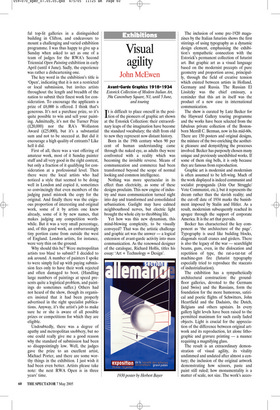Revelation of space and time
Andrew Lambirth on an exhibition by one of the country’s foremost sculptors
Forms in Light and Shade, an exhibition of Nigel Hall’s new work at Annely Juda Fine Art (23 Dering Street, W1, until 14 May), confirms him as one of our foremost sculptors, who has received too little official recognition in his country of origin and residence. Significantly he is highly regarded abroad — in Europe, America and the Far East — which suggests that his work has an international rather than cosily local appeal. It does, but that is no excuse for the lack of a proper museum retrospective in Britain. Thankfully, there are rumours of a substantial public showing, which I hope will be confirmed in due course. In the meantime, to see his work we have to rely on the commercial sector: in this case, on the good offices of Annely Juda and its stunningly lit galleries just off New Bond Street. a form-within-a-form ovoid sculpture, respectively in aluminium and polished wood, are equally but differently appealing?
With regard to this particular group of work, Hall himself has written of his deep feelings for the Mani, that area of the southern Greek Peloponnese the light and landscape forms of which have stimulated some of his most evocative new pieces. These are about sculpture on a grand, elemental scale — the meeting-point of land and sea. Here in his wooden ellipses and poignant curves are to be found suggested the effects of wind and water, clear light and shade, all the complex details of cliffs and outcrops, caves and concavities, revealed by the sun or filled with deep shadows. As he writes: ‘To swim and drift in these translucent waters and observe the slowly changing relationships of promontories, bays and islands set against the embracing arc of the horizon is a revelation of space and time.’ Leafing through the lavish catalogue of his recent museum exhibition in Mannheim, Germany, I was struck by the subtle play of variations Hall achieves with his understanding of universal forms and structures. The truncated cone, the oval, the wedge — with these basic elements he constructs objects of great power and beauty which have a rare naturalness, an unquestionable reason to exist in this strange world. They are clearly man-made but have a rightness, an inevitability to them which is utterly beguiling. They add something to the small stock of truth against which human stupidity and greed shall not prevail.
Nigel Hall was born in Bristol, and, as an alumnus of that city’s West of England College of Art, he has on occasion contributed work to the annual salon of the Royal West of England Academy. (This is an autumn exhibition as opposed to the London Royal Academy’s summer show.) I am a supporter of the RWA, which has beauti ful top-lit galleries in a distinguished building in Clifton, and endeavours to mount a challenging and varied exhibition programme. I was thus happy to give up a Sunday when asked to act as one of a team of judges for the RWA’s Second Triennial Open Painting exhibition in early April (until 4 June). Sadly, the experience was rather a disheartening one.
The key word in the exhibition’s title is ‘Open’, indicating that it is not a restricted or local submission, but invites artists throughout the length and breadth of the nation to submit their finest work for consideration. To encourage the applicants a prize of £8,000 is offered. I think that’s generous. It’s not a purchase prize, so it’s quite possible to win and sell your painting. Admittedly, it’s not the Turner Prize (£20,000) nor the RA’s Wollaston Award (£25,000), but it’s a substantial sum and not to be sneezed at. But did it encourage a high quality of entrants? Like hell it did.
First of all, there was a vast offering of amateur work, most of it Sunday painter stuff and all very good in the right context, but only a fraction of it qualifying for consideration at a professional level. Then there were the local artists who had noticed a style that seemed to be doing well in London and copied it, sometimes so convincingly that even members of the judging panel mistook the copy for the original. And finally there was the exiguous proportion of interesting and original work, some of it by artists one knew already, some of it by new names, that makes judging any competition worthwhile. But it was a very small percentage, and, of this good work, an embarrassingly tiny portion came from outside the west of England. London artists, for instance, were very thin on the ground.
Why should this be? Were metropolitan artists too blasé to submit? I decided to ask around. A number of painters I spoke to were simply fed up with paying submission fees only to have their work rejected and often damaged to boot. (Handling large numbers of paintings at speed presents quite a logistical problem, and paintings do sometimes suffer.) Others had not heard of the show, though its organisers insisted that it had been properly advertised in the right specialist publications. Anyway, it’s the artist’s job to make sure he or she is aware of all possible prizes or competitions for which they are eligible.
Undoubtedly, there was a degree of apathy and metropolitan snobbery, but no one could really give me a good reason why the standard of submission had been so disappointingly low. Well, the judges gave the prize to an excellent artist, Michael Porter, and there are some worthy things in the exhibition. I just wish it had been even better. Artists please take note: the next RWA Open is in three years’ time.




























































 Previous page
Previous page